Annotated Bibliography: Emerging Technologies and Innovation Report
VerifiedAdded on 2023/04/25
|11
|3289
|337
Report
AI Summary
This annotated bibliography provides an overview of research on emerging technologies and innovation, specifically focusing on applications within the healthcare sector. The bibliography includes summaries of various articles exploring the use of Internet of Things (IoT) devices, wearable sensors, and machine learning algorithms for health monitoring, data collection, and analysis. The studies address various aspects, including security and privacy concerns, authentication methods, and the development of smart systems for elderly care and patient monitoring. Several papers highlight the application of these technologies for remote health monitoring, activity recognition, and early detection of health conditions like migraine attacks and eclamptic seizures. Furthermore, the bibliography examines the challenges and opportunities associated with the implementation of these technologies, including the need for robust data security measures, efficient data processing methods, and the development of user-friendly interfaces. The articles also explore the use of blockchain technology for secure data management and the development of hybrid systems combining wearable sensors and low-power wide-area networks for improved safety and health monitoring. The annotated bibliography underscores the potential of these technologies to improve healthcare services and patient outcomes while also addressing critical challenges such as data security and privacy.
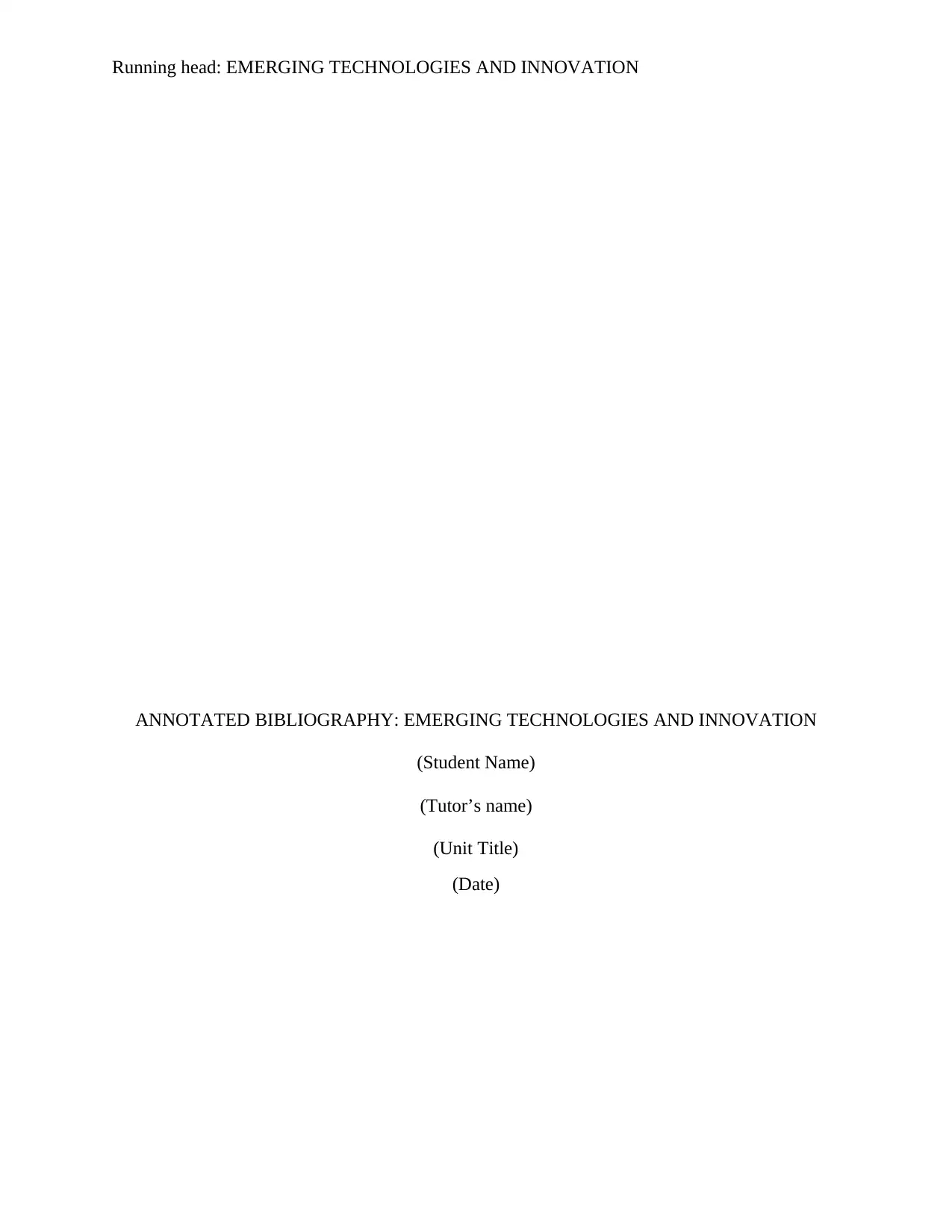
Running head: EMERGING TECHNOLOGIES AND INNOVATION
ANNOTATED BIBLIOGRAPHY: EMERGING TECHNOLOGIES AND INNOVATION
(Student Name)
(Tutor’s name)
(Unit Title)
(Date)
ANNOTATED BIBLIOGRAPHY: EMERGING TECHNOLOGIES AND INNOVATION
(Student Name)
(Tutor’s name)
(Unit Title)
(Date)
Paraphrase This Document
Need a fresh take? Get an instant paraphrase of this document with our AI Paraphraser
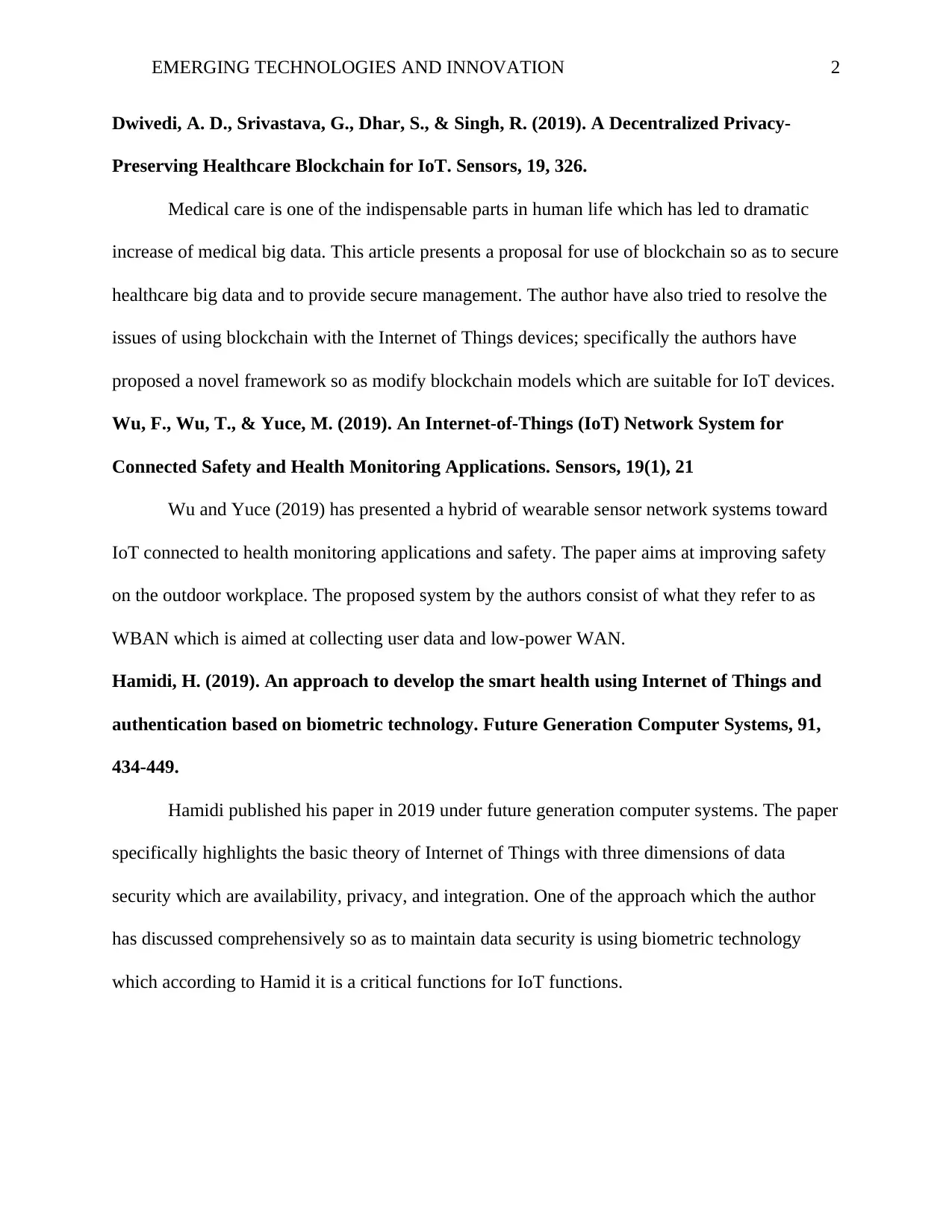
EMERGING TECHNOLOGIES AND INNOVATION 2
Dwivedi, A. D., Srivastava, G., Dhar, S., & Singh, R. (2019). A Decentralized Privacy-
Preserving Healthcare Blockchain for IoT. Sensors, 19, 326.
Medical care is one of the indispensable parts in human life which has led to dramatic
increase of medical big data. This article presents a proposal for use of blockchain so as to secure
healthcare big data and to provide secure management. The author have also tried to resolve the
issues of using blockchain with the Internet of Things devices; specifically the authors have
proposed a novel framework so as modify blockchain models which are suitable for IoT devices.
Wu, F., Wu, T., & Yuce, M. (2019). An Internet-of-Things (IoT) Network System for
Connected Safety and Health Monitoring Applications. Sensors, 19(1), 21
Wu and Yuce (2019) has presented a hybrid of wearable sensor network systems toward
IoT connected to health monitoring applications and safety. The paper aims at improving safety
on the outdoor workplace. The proposed system by the authors consist of what they refer to as
WBAN which is aimed at collecting user data and low-power WAN.
Hamidi, H. (2019). An approach to develop the smart health using Internet of Things and
authentication based on biometric technology. Future Generation Computer Systems, 91,
434-449.
Hamidi published his paper in 2019 under future generation computer systems. The paper
specifically highlights the basic theory of Internet of Things with three dimensions of data
security which are availability, privacy, and integration. One of the approach which the author
has discussed comprehensively so as to maintain data security is using biometric technology
which according to Hamid it is a critical functions for IoT functions.
Dwivedi, A. D., Srivastava, G., Dhar, S., & Singh, R. (2019). A Decentralized Privacy-
Preserving Healthcare Blockchain for IoT. Sensors, 19, 326.
Medical care is one of the indispensable parts in human life which has led to dramatic
increase of medical big data. This article presents a proposal for use of blockchain so as to secure
healthcare big data and to provide secure management. The author have also tried to resolve the
issues of using blockchain with the Internet of Things devices; specifically the authors have
proposed a novel framework so as modify blockchain models which are suitable for IoT devices.
Wu, F., Wu, T., & Yuce, M. (2019). An Internet-of-Things (IoT) Network System for
Connected Safety and Health Monitoring Applications. Sensors, 19(1), 21
Wu and Yuce (2019) has presented a hybrid of wearable sensor network systems toward
IoT connected to health monitoring applications and safety. The paper aims at improving safety
on the outdoor workplace. The proposed system by the authors consist of what they refer to as
WBAN which is aimed at collecting user data and low-power WAN.
Hamidi, H. (2019). An approach to develop the smart health using Internet of Things and
authentication based on biometric technology. Future Generation Computer Systems, 91,
434-449.
Hamidi published his paper in 2019 under future generation computer systems. The paper
specifically highlights the basic theory of Internet of Things with three dimensions of data
security which are availability, privacy, and integration. One of the approach which the author
has discussed comprehensively so as to maintain data security is using biometric technology
which according to Hamid it is a critical functions for IoT functions.
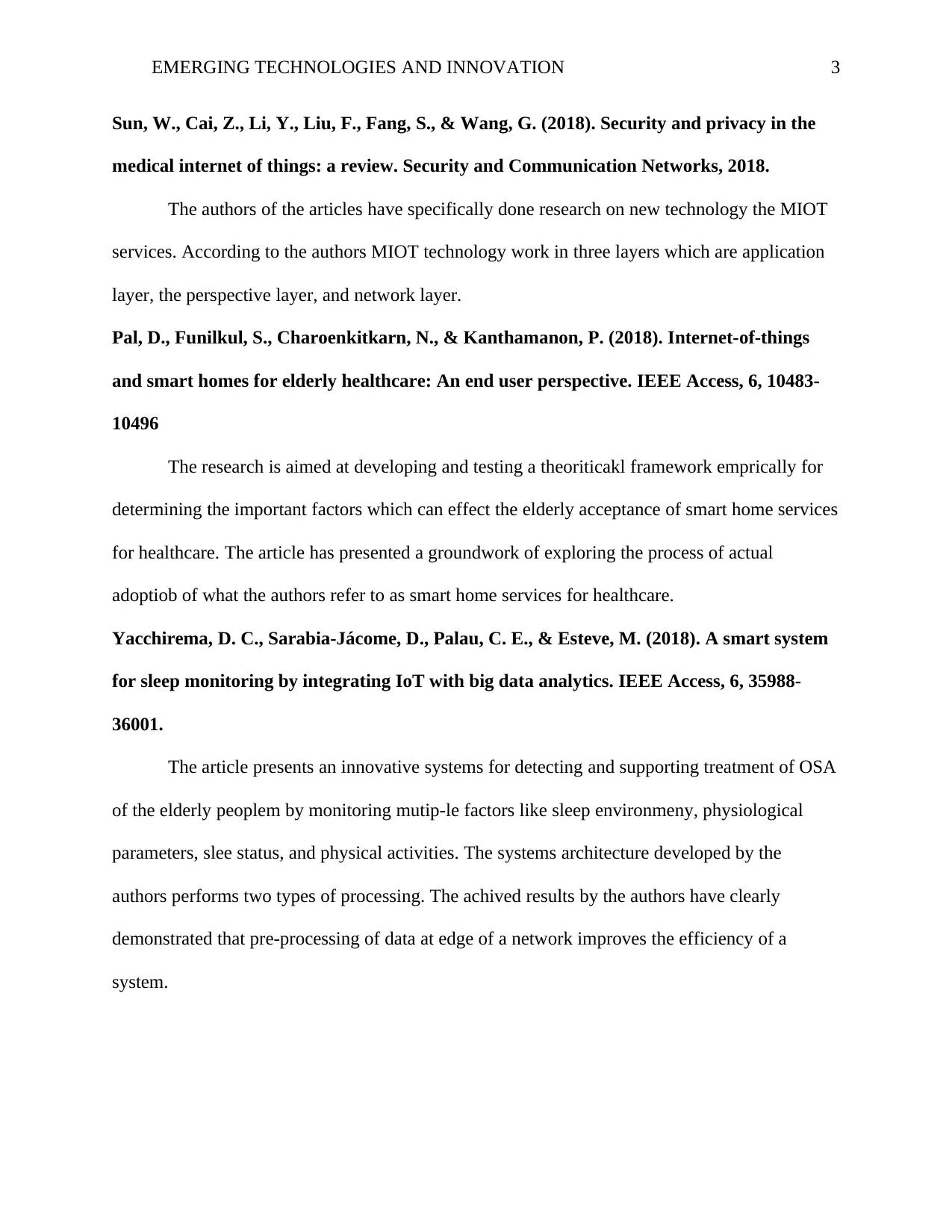
EMERGING TECHNOLOGIES AND INNOVATION 3
Sun, W., Cai, Z., Li, Y., Liu, F., Fang, S., & Wang, G. (2018). Security and privacy in the
medical internet of things: a review. Security and Communication Networks, 2018.
The authors of the articles have specifically done research on new technology the MIOT
services. According to the authors MIOT technology work in three layers which are application
layer, the perspective layer, and network layer.
Pal, D., Funilkul, S., Charoenkitkarn, N., & Kanthamanon, P. (2018). Internet-of-things
and smart homes for elderly healthcare: An end user perspective. IEEE Access, 6, 10483-
10496
The research is aimed at developing and testing a theoriticakl framework emprically for
determining the important factors which can effect the elderly acceptance of smart home services
for healthcare. The article has presented a groundwork of exploring the process of actual
adoptiob of what the authors refer to as smart home services for healthcare.
Yacchirema, D. C., Sarabia-Jácome, D., Palau, C. E., & Esteve, M. (2018). A smart system
for sleep monitoring by integrating IoT with big data analytics. IEEE Access, 6, 35988-
36001.
The article presents an innovative systems for detecting and supporting treatment of OSA
of the elderly peoplem by monitoring mutip-le factors like sleep environmeny, physiological
parameters, slee status, and physical activities. The systems architecture developed by the
authors performs two types of processing. The achived results by the authors have clearly
demonstrated that pre-processing of data at edge of a network improves the efficiency of a
system.
Sun, W., Cai, Z., Li, Y., Liu, F., Fang, S., & Wang, G. (2018). Security and privacy in the
medical internet of things: a review. Security and Communication Networks, 2018.
The authors of the articles have specifically done research on new technology the MIOT
services. According to the authors MIOT technology work in three layers which are application
layer, the perspective layer, and network layer.
Pal, D., Funilkul, S., Charoenkitkarn, N., & Kanthamanon, P. (2018). Internet-of-things
and smart homes for elderly healthcare: An end user perspective. IEEE Access, 6, 10483-
10496
The research is aimed at developing and testing a theoriticakl framework emprically for
determining the important factors which can effect the elderly acceptance of smart home services
for healthcare. The article has presented a groundwork of exploring the process of actual
adoptiob of what the authors refer to as smart home services for healthcare.
Yacchirema, D. C., Sarabia-Jácome, D., Palau, C. E., & Esteve, M. (2018). A smart system
for sleep monitoring by integrating IoT with big data analytics. IEEE Access, 6, 35988-
36001.
The article presents an innovative systems for detecting and supporting treatment of OSA
of the elderly peoplem by monitoring mutip-le factors like sleep environmeny, physiological
parameters, slee status, and physical activities. The systems architecture developed by the
authors performs two types of processing. The achived results by the authors have clearly
demonstrated that pre-processing of data at edge of a network improves the efficiency of a
system.
⊘ This is a preview!⊘
Do you want full access?
Subscribe today to unlock all pages.

Trusted by 1+ million students worldwide
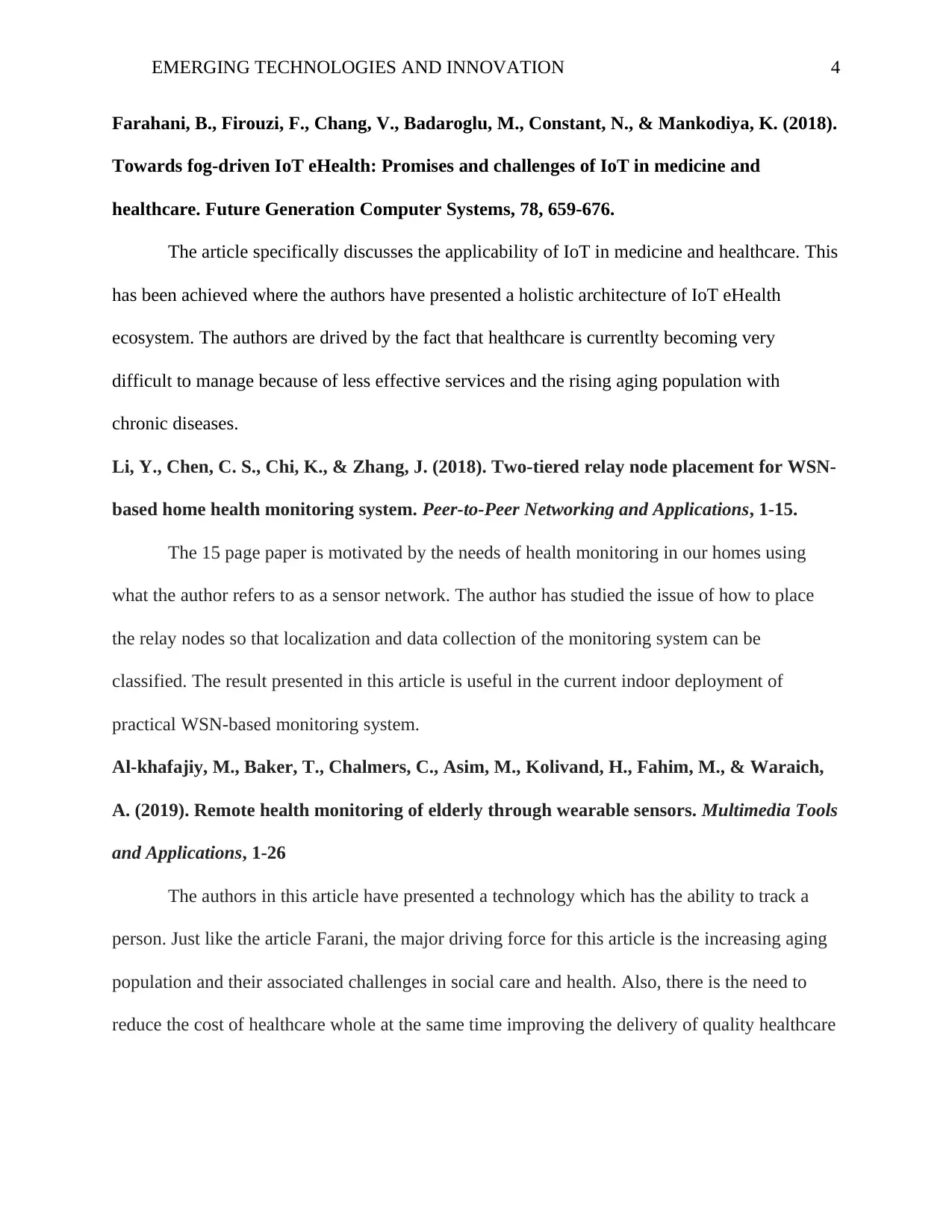
EMERGING TECHNOLOGIES AND INNOVATION 4
Farahani, B., Firouzi, F., Chang, V., Badaroglu, M., Constant, N., & Mankodiya, K. (2018).
Towards fog-driven IoT eHealth: Promises and challenges of IoT in medicine and
healthcare. Future Generation Computer Systems, 78, 659-676.
The article specifically discusses the applicability of IoT in medicine and healthcare. This
has been achieved where the authors have presented a holistic architecture of IoT eHealth
ecosystem. The authors are drived by the fact that healthcare is currentlty becoming very
difficult to manage because of less effective services and the rising aging population with
chronic diseases.
Li, Y., Chen, C. S., Chi, K., & Zhang, J. (2018). Two-tiered relay node placement for WSN-
based home health monitoring system. Peer-to-Peer Networking and Applications, 1-15.
The 15 page paper is motivated by the needs of health monitoring in our homes using
what the author refers to as a sensor network. The author has studied the issue of how to place
the relay nodes so that localization and data collection of the monitoring system can be
classified. The result presented in this article is useful in the current indoor deployment of
practical WSN-based monitoring system.
Al-khafajiy, M., Baker, T., Chalmers, C., Asim, M., Kolivand, H., Fahim, M., & Waraich,
A. (2019). Remote health monitoring of elderly through wearable sensors. Multimedia Tools
and Applications, 1-26
The authors in this article have presented a technology which has the ability to track a
person. Just like the article Farani, the major driving force for this article is the increasing aging
population and their associated challenges in social care and health. Also, there is the need to
reduce the cost of healthcare whole at the same time improving the delivery of quality healthcare
Farahani, B., Firouzi, F., Chang, V., Badaroglu, M., Constant, N., & Mankodiya, K. (2018).
Towards fog-driven IoT eHealth: Promises and challenges of IoT in medicine and
healthcare. Future Generation Computer Systems, 78, 659-676.
The article specifically discusses the applicability of IoT in medicine and healthcare. This
has been achieved where the authors have presented a holistic architecture of IoT eHealth
ecosystem. The authors are drived by the fact that healthcare is currentlty becoming very
difficult to manage because of less effective services and the rising aging population with
chronic diseases.
Li, Y., Chen, C. S., Chi, K., & Zhang, J. (2018). Two-tiered relay node placement for WSN-
based home health monitoring system. Peer-to-Peer Networking and Applications, 1-15.
The 15 page paper is motivated by the needs of health monitoring in our homes using
what the author refers to as a sensor network. The author has studied the issue of how to place
the relay nodes so that localization and data collection of the monitoring system can be
classified. The result presented in this article is useful in the current indoor deployment of
practical WSN-based monitoring system.
Al-khafajiy, M., Baker, T., Chalmers, C., Asim, M., Kolivand, H., Fahim, M., & Waraich,
A. (2019). Remote health monitoring of elderly through wearable sensors. Multimedia Tools
and Applications, 1-26
The authors in this article have presented a technology which has the ability to track a
person. Just like the article Farani, the major driving force for this article is the increasing aging
population and their associated challenges in social care and health. Also, there is the need to
reduce the cost of healthcare whole at the same time improving the delivery of quality healthcare
Paraphrase This Document
Need a fresh take? Get an instant paraphrase of this document with our AI Paraphraser
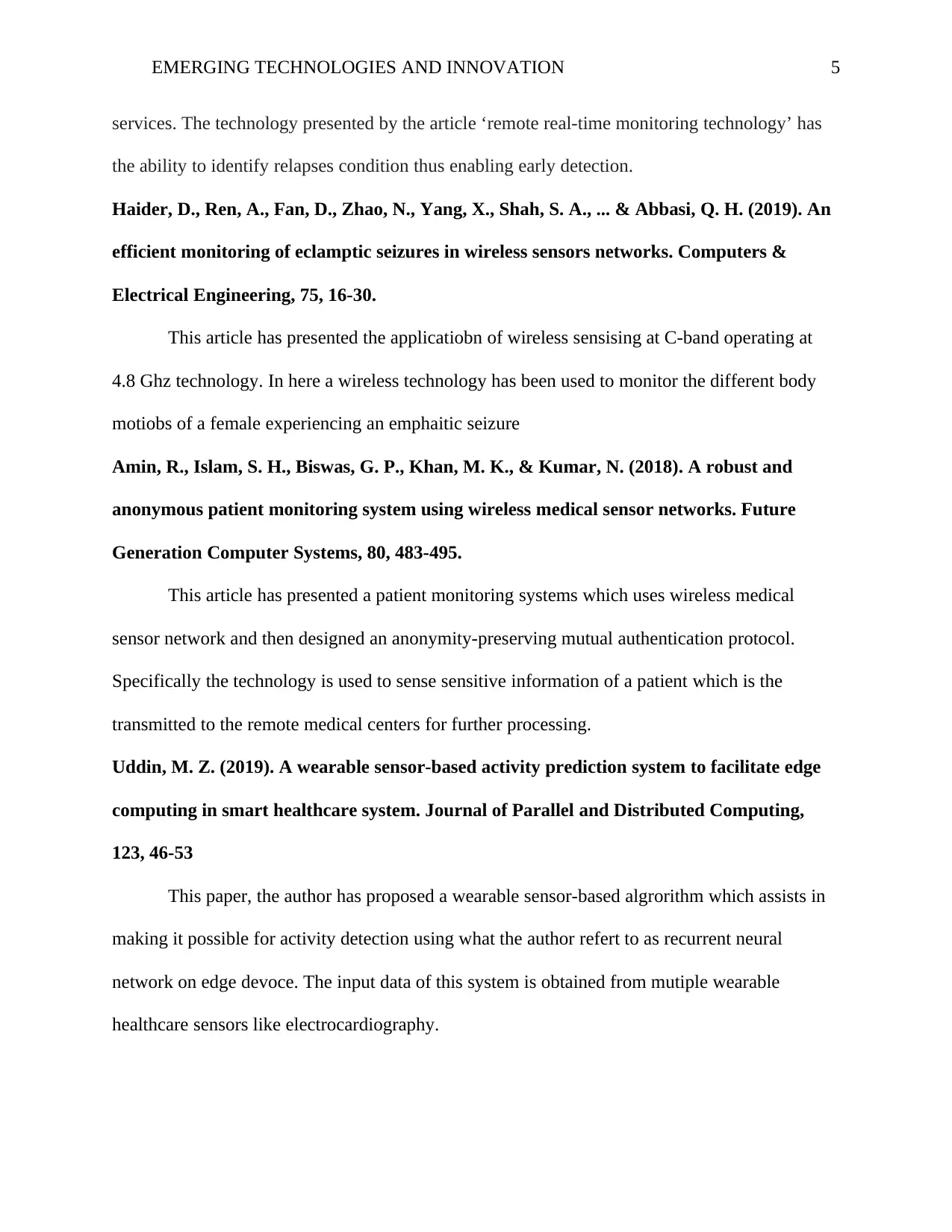
EMERGING TECHNOLOGIES AND INNOVATION 5
services. The technology presented by the article ‘remote real-time monitoring technology’ has
the ability to identify relapses condition thus enabling early detection.
Haider, D., Ren, A., Fan, D., Zhao, N., Yang, X., Shah, S. A., ... & Abbasi, Q. H. (2019). An
efficient monitoring of eclamptic seizures in wireless sensors networks. Computers &
Electrical Engineering, 75, 16-30.
This article has presented the applicatiobn of wireless sensising at C-band operating at
4.8 Ghz technology. In here a wireless technology has been used to monitor the different body
motiobs of a female experiencing an emphaitic seizure
Amin, R., Islam, S. H., Biswas, G. P., Khan, M. K., & Kumar, N. (2018). A robust and
anonymous patient monitoring system using wireless medical sensor networks. Future
Generation Computer Systems, 80, 483-495.
This article has presented a patient monitoring systems which uses wireless medical
sensor network and then designed an anonymity-preserving mutual authentication protocol.
Specifically the technology is used to sense sensitive information of a patient which is the
transmitted to the remote medical centers for further processing.
Uddin, M. Z. (2019). A wearable sensor-based activity prediction system to facilitate edge
computing in smart healthcare system. Journal of Parallel and Distributed Computing,
123, 46-53
This paper, the author has proposed a wearable sensor-based algrorithm which assists in
making it possible for activity detection using what the author refert to as recurrent neural
network on edge devoce. The input data of this system is obtained from mutiple wearable
healthcare sensors like electrocardiography.
services. The technology presented by the article ‘remote real-time monitoring technology’ has
the ability to identify relapses condition thus enabling early detection.
Haider, D., Ren, A., Fan, D., Zhao, N., Yang, X., Shah, S. A., ... & Abbasi, Q. H. (2019). An
efficient monitoring of eclamptic seizures in wireless sensors networks. Computers &
Electrical Engineering, 75, 16-30.
This article has presented the applicatiobn of wireless sensising at C-band operating at
4.8 Ghz technology. In here a wireless technology has been used to monitor the different body
motiobs of a female experiencing an emphaitic seizure
Amin, R., Islam, S. H., Biswas, G. P., Khan, M. K., & Kumar, N. (2018). A robust and
anonymous patient monitoring system using wireless medical sensor networks. Future
Generation Computer Systems, 80, 483-495.
This article has presented a patient monitoring systems which uses wireless medical
sensor network and then designed an anonymity-preserving mutual authentication protocol.
Specifically the technology is used to sense sensitive information of a patient which is the
transmitted to the remote medical centers for further processing.
Uddin, M. Z. (2019). A wearable sensor-based activity prediction system to facilitate edge
computing in smart healthcare system. Journal of Parallel and Distributed Computing,
123, 46-53
This paper, the author has proposed a wearable sensor-based algrorithm which assists in
making it possible for activity detection using what the author refert to as recurrent neural
network on edge devoce. The input data of this system is obtained from mutiple wearable
healthcare sensors like electrocardiography.
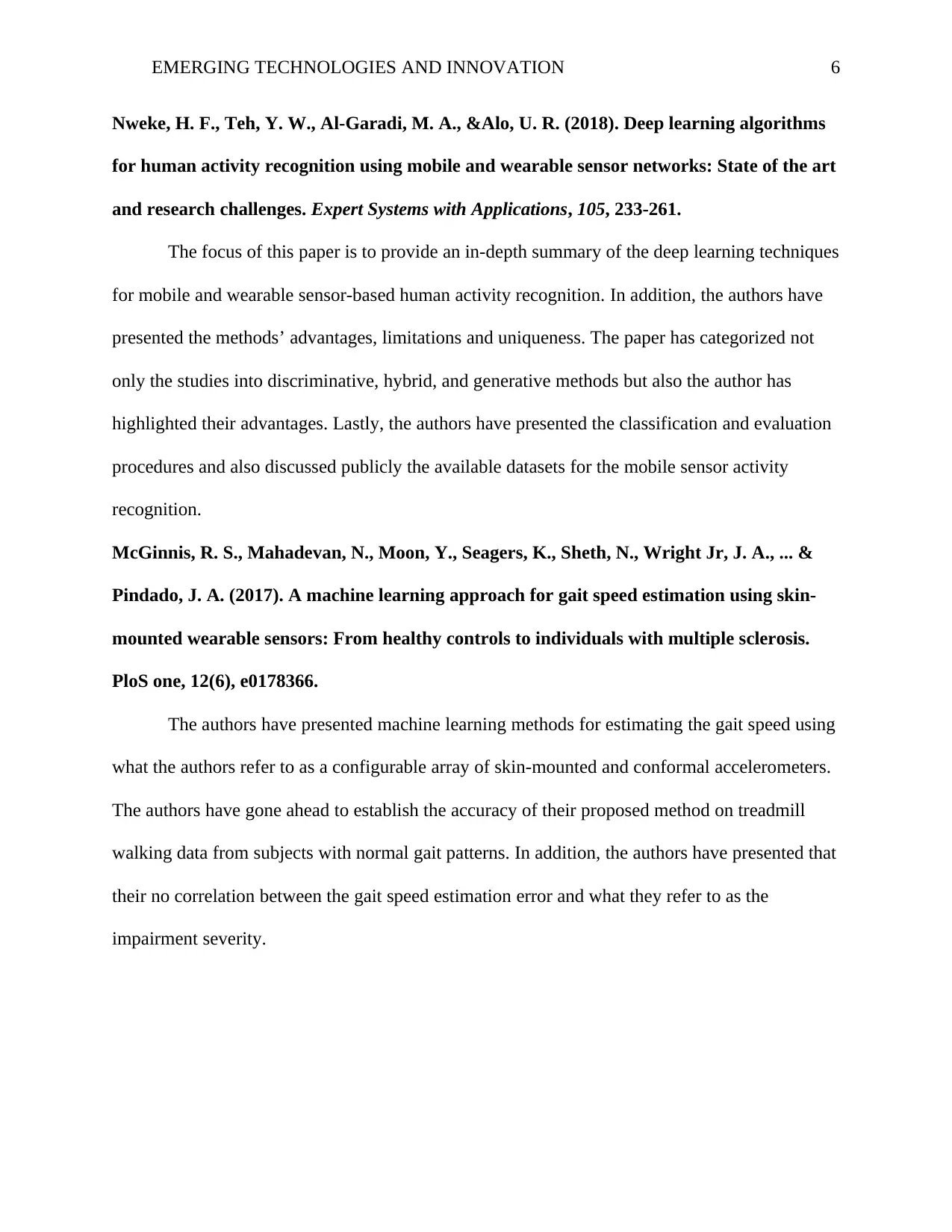
EMERGING TECHNOLOGIES AND INNOVATION 6
Nweke, H. F., Teh, Y. W., Al-Garadi, M. A., &Alo, U. R. (2018). Deep learning algorithms
for human activity recognition using mobile and wearable sensor networks: State of the art
and research challenges. Expert Systems with Applications, 105, 233-261.
The focus of this paper is to provide an in-depth summary of the deep learning techniques
for mobile and wearable sensor-based human activity recognition. In addition, the authors have
presented the methods’ advantages, limitations and uniqueness. The paper has categorized not
only the studies into discriminative, hybrid, and generative methods but also the author has
highlighted their advantages. Lastly, the authors have presented the classification and evaluation
procedures and also discussed publicly the available datasets for the mobile sensor activity
recognition.
McGinnis, R. S., Mahadevan, N., Moon, Y., Seagers, K., Sheth, N., Wright Jr, J. A., ... &
Pindado, J. A. (2017). A machine learning approach for gait speed estimation using skin-
mounted wearable sensors: From healthy controls to individuals with multiple sclerosis.
PloS one, 12(6), e0178366.
The authors have presented machine learning methods for estimating the gait speed using
what the authors refer to as a configurable array of skin-mounted and conformal accelerometers.
The authors have gone ahead to establish the accuracy of their proposed method on treadmill
walking data from subjects with normal gait patterns. In addition, the authors have presented that
their no correlation between the gait speed estimation error and what they refer to as the
impairment severity.
Nweke, H. F., Teh, Y. W., Al-Garadi, M. A., &Alo, U. R. (2018). Deep learning algorithms
for human activity recognition using mobile and wearable sensor networks: State of the art
and research challenges. Expert Systems with Applications, 105, 233-261.
The focus of this paper is to provide an in-depth summary of the deep learning techniques
for mobile and wearable sensor-based human activity recognition. In addition, the authors have
presented the methods’ advantages, limitations and uniqueness. The paper has categorized not
only the studies into discriminative, hybrid, and generative methods but also the author has
highlighted their advantages. Lastly, the authors have presented the classification and evaluation
procedures and also discussed publicly the available datasets for the mobile sensor activity
recognition.
McGinnis, R. S., Mahadevan, N., Moon, Y., Seagers, K., Sheth, N., Wright Jr, J. A., ... &
Pindado, J. A. (2017). A machine learning approach for gait speed estimation using skin-
mounted wearable sensors: From healthy controls to individuals with multiple sclerosis.
PloS one, 12(6), e0178366.
The authors have presented machine learning methods for estimating the gait speed using
what the authors refer to as a configurable array of skin-mounted and conformal accelerometers.
The authors have gone ahead to establish the accuracy of their proposed method on treadmill
walking data from subjects with normal gait patterns. In addition, the authors have presented that
their no correlation between the gait speed estimation error and what they refer to as the
impairment severity.
⊘ This is a preview!⊘
Do you want full access?
Subscribe today to unlock all pages.

Trusted by 1+ million students worldwide
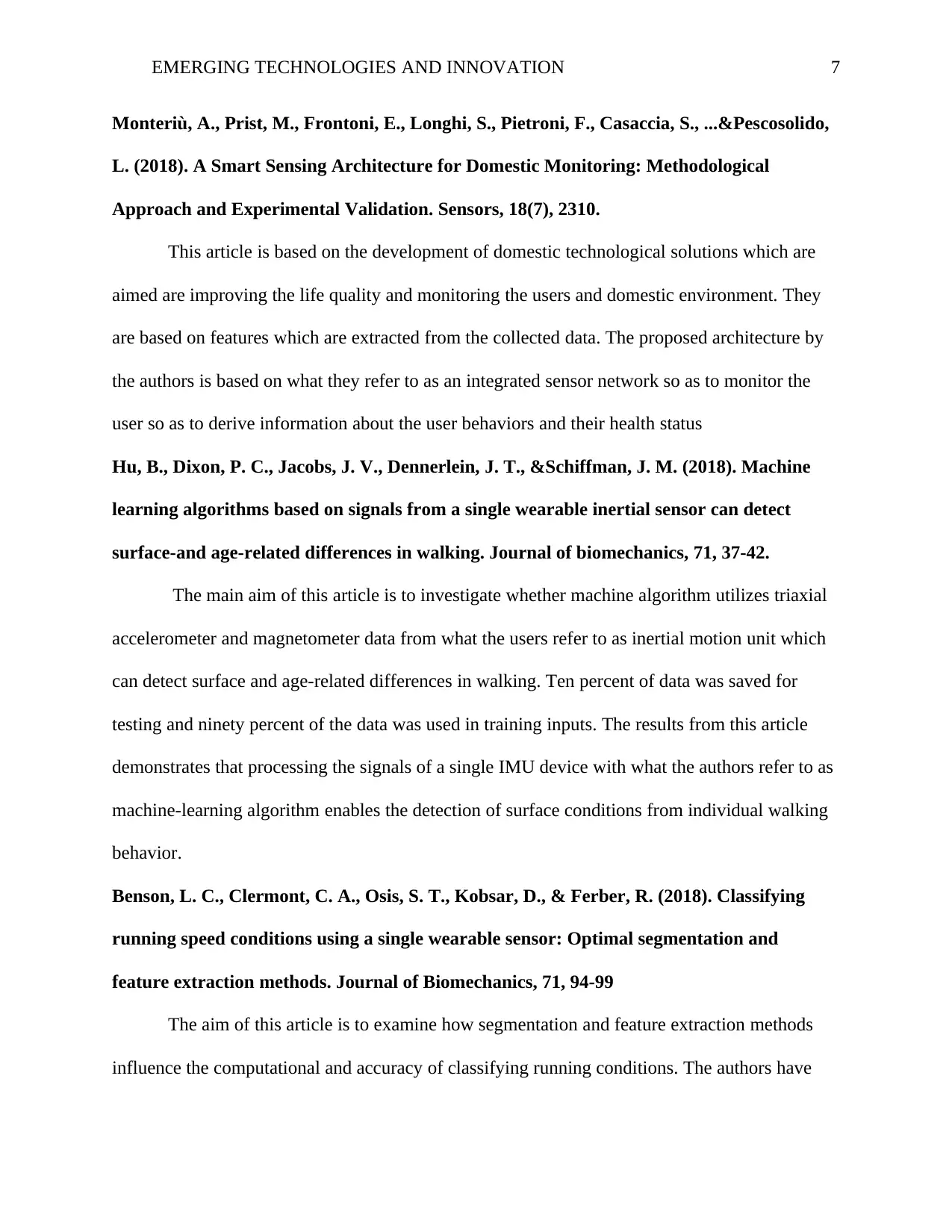
EMERGING TECHNOLOGIES AND INNOVATION 7
Monteriù, A., Prist, M., Frontoni, E., Longhi, S., Pietroni, F., Casaccia, S., ...&Pescosolido,
L. (2018). A Smart Sensing Architecture for Domestic Monitoring: Methodological
Approach and Experimental Validation. Sensors, 18(7), 2310.
This article is based on the development of domestic technological solutions which are
aimed are improving the life quality and monitoring the users and domestic environment. They
are based on features which are extracted from the collected data. The proposed architecture by
the authors is based on what they refer to as an integrated sensor network so as to monitor the
user so as to derive information about the user behaviors and their health status
Hu, B., Dixon, P. C., Jacobs, J. V., Dennerlein, J. T., &Schiffman, J. M. (2018). Machine
learning algorithms based on signals from a single wearable inertial sensor can detect
surface-and age-related differences in walking. Journal of biomechanics, 71, 37-42.
The main aim of this article is to investigate whether machine algorithm utilizes triaxial
accelerometer and magnetometer data from what the users refer to as inertial motion unit which
can detect surface and age-related differences in walking. Ten percent of data was saved for
testing and ninety percent of the data was used in training inputs. The results from this article
demonstrates that processing the signals of a single IMU device with what the authors refer to as
machine-learning algorithm enables the detection of surface conditions from individual walking
behavior.
Benson, L. C., Clermont, C. A., Osis, S. T., Kobsar, D., & Ferber, R. (2018). Classifying
running speed conditions using a single wearable sensor: Optimal segmentation and
feature extraction methods. Journal of Biomechanics, 71, 94-99
The aim of this article is to examine how segmentation and feature extraction methods
influence the computational and accuracy of classifying running conditions. The authors have
Monteriù, A., Prist, M., Frontoni, E., Longhi, S., Pietroni, F., Casaccia, S., ...&Pescosolido,
L. (2018). A Smart Sensing Architecture for Domestic Monitoring: Methodological
Approach and Experimental Validation. Sensors, 18(7), 2310.
This article is based on the development of domestic technological solutions which are
aimed are improving the life quality and monitoring the users and domestic environment. They
are based on features which are extracted from the collected data. The proposed architecture by
the authors is based on what they refer to as an integrated sensor network so as to monitor the
user so as to derive information about the user behaviors and their health status
Hu, B., Dixon, P. C., Jacobs, J. V., Dennerlein, J. T., &Schiffman, J. M. (2018). Machine
learning algorithms based on signals from a single wearable inertial sensor can detect
surface-and age-related differences in walking. Journal of biomechanics, 71, 37-42.
The main aim of this article is to investigate whether machine algorithm utilizes triaxial
accelerometer and magnetometer data from what the users refer to as inertial motion unit which
can detect surface and age-related differences in walking. Ten percent of data was saved for
testing and ninety percent of the data was used in training inputs. The results from this article
demonstrates that processing the signals of a single IMU device with what the authors refer to as
machine-learning algorithm enables the detection of surface conditions from individual walking
behavior.
Benson, L. C., Clermont, C. A., Osis, S. T., Kobsar, D., & Ferber, R. (2018). Classifying
running speed conditions using a single wearable sensor: Optimal segmentation and
feature extraction methods. Journal of Biomechanics, 71, 94-99
The aim of this article is to examine how segmentation and feature extraction methods
influence the computational and accuracy of classifying running conditions. The authors have
Paraphrase This Document
Need a fresh take? Get an instant paraphrase of this document with our AI Paraphraser
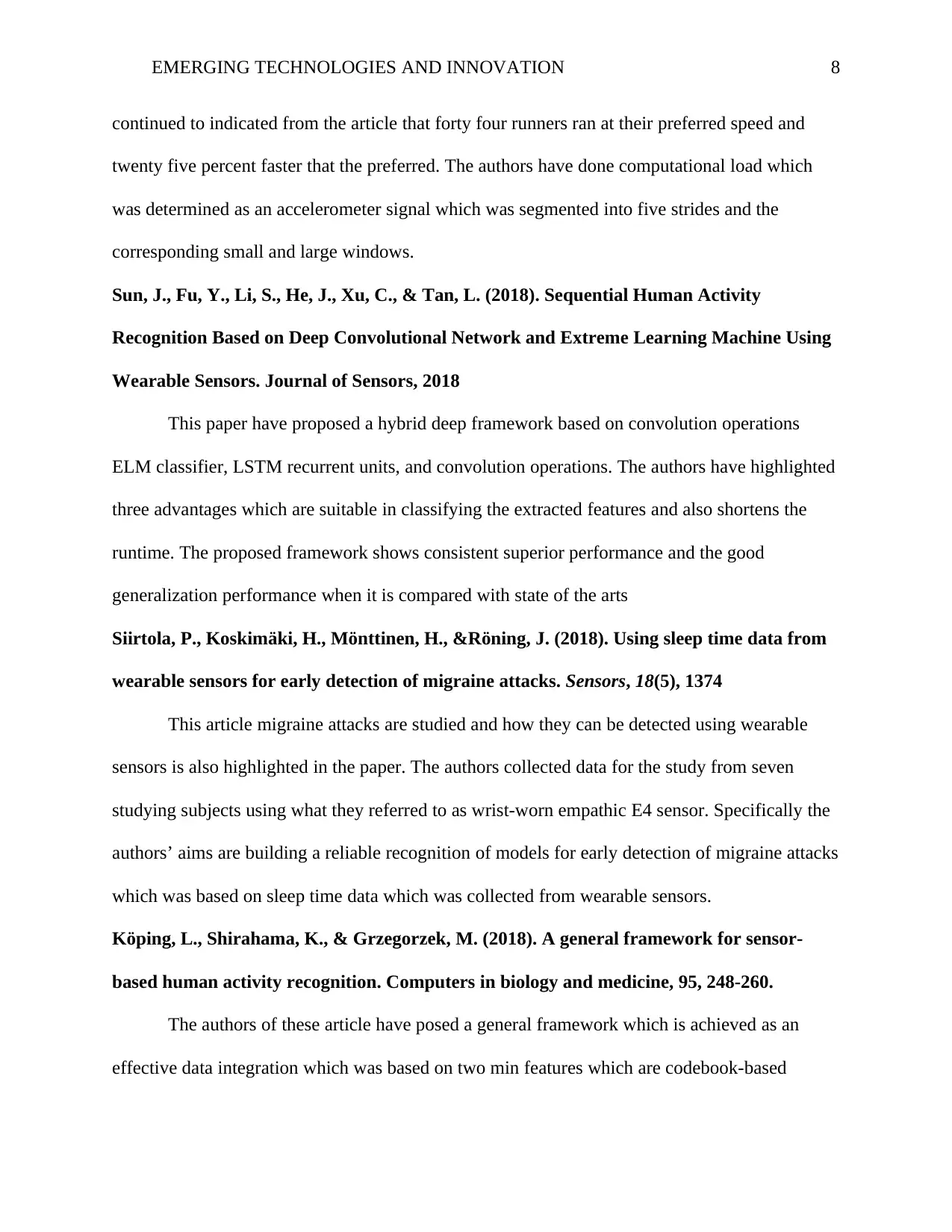
EMERGING TECHNOLOGIES AND INNOVATION 8
continued to indicated from the article that forty four runners ran at their preferred speed and
twenty five percent faster that the preferred. The authors have done computational load which
was determined as an accelerometer signal which was segmented into five strides and the
corresponding small and large windows.
Sun, J., Fu, Y., Li, S., He, J., Xu, C., & Tan, L. (2018). Sequential Human Activity
Recognition Based on Deep Convolutional Network and Extreme Learning Machine Using
Wearable Sensors. Journal of Sensors, 2018
This paper have proposed a hybrid deep framework based on convolution operations
ELM classifier, LSTM recurrent units, and convolution operations. The authors have highlighted
three advantages which are suitable in classifying the extracted features and also shortens the
runtime. The proposed framework shows consistent superior performance and the good
generalization performance when it is compared with state of the arts
Siirtola, P., Koskimäki, H., Mönttinen, H., &Röning, J. (2018). Using sleep time data from
wearable sensors for early detection of migraine attacks. Sensors, 18(5), 1374
This article migraine attacks are studied and how they can be detected using wearable
sensors is also highlighted in the paper. The authors collected data for the study from seven
studying subjects using what they referred to as wrist-worn empathic E4 sensor. Specifically the
authors’ aims are building a reliable recognition of models for early detection of migraine attacks
which was based on sleep time data which was collected from wearable sensors.
Köping, L., Shirahama, K., & Grzegorzek, M. (2018). A general framework for sensor-
based human activity recognition. Computers in biology and medicine, 95, 248-260.
The authors of these article have posed a general framework which is achieved as an
effective data integration which was based on two min features which are codebook-based
continued to indicated from the article that forty four runners ran at their preferred speed and
twenty five percent faster that the preferred. The authors have done computational load which
was determined as an accelerometer signal which was segmented into five strides and the
corresponding small and large windows.
Sun, J., Fu, Y., Li, S., He, J., Xu, C., & Tan, L. (2018). Sequential Human Activity
Recognition Based on Deep Convolutional Network and Extreme Learning Machine Using
Wearable Sensors. Journal of Sensors, 2018
This paper have proposed a hybrid deep framework based on convolution operations
ELM classifier, LSTM recurrent units, and convolution operations. The authors have highlighted
three advantages which are suitable in classifying the extracted features and also shortens the
runtime. The proposed framework shows consistent superior performance and the good
generalization performance when it is compared with state of the arts
Siirtola, P., Koskimäki, H., Mönttinen, H., &Röning, J. (2018). Using sleep time data from
wearable sensors for early detection of migraine attacks. Sensors, 18(5), 1374
This article migraine attacks are studied and how they can be detected using wearable
sensors is also highlighted in the paper. The authors collected data for the study from seven
studying subjects using what they referred to as wrist-worn empathic E4 sensor. Specifically the
authors’ aims are building a reliable recognition of models for early detection of migraine attacks
which was based on sleep time data which was collected from wearable sensors.
Köping, L., Shirahama, K., & Grzegorzek, M. (2018). A general framework for sensor-
based human activity recognition. Computers in biology and medicine, 95, 248-260.
The authors of these article have posed a general framework which is achieved as an
effective data integration which was based on two min features which are codebook-based
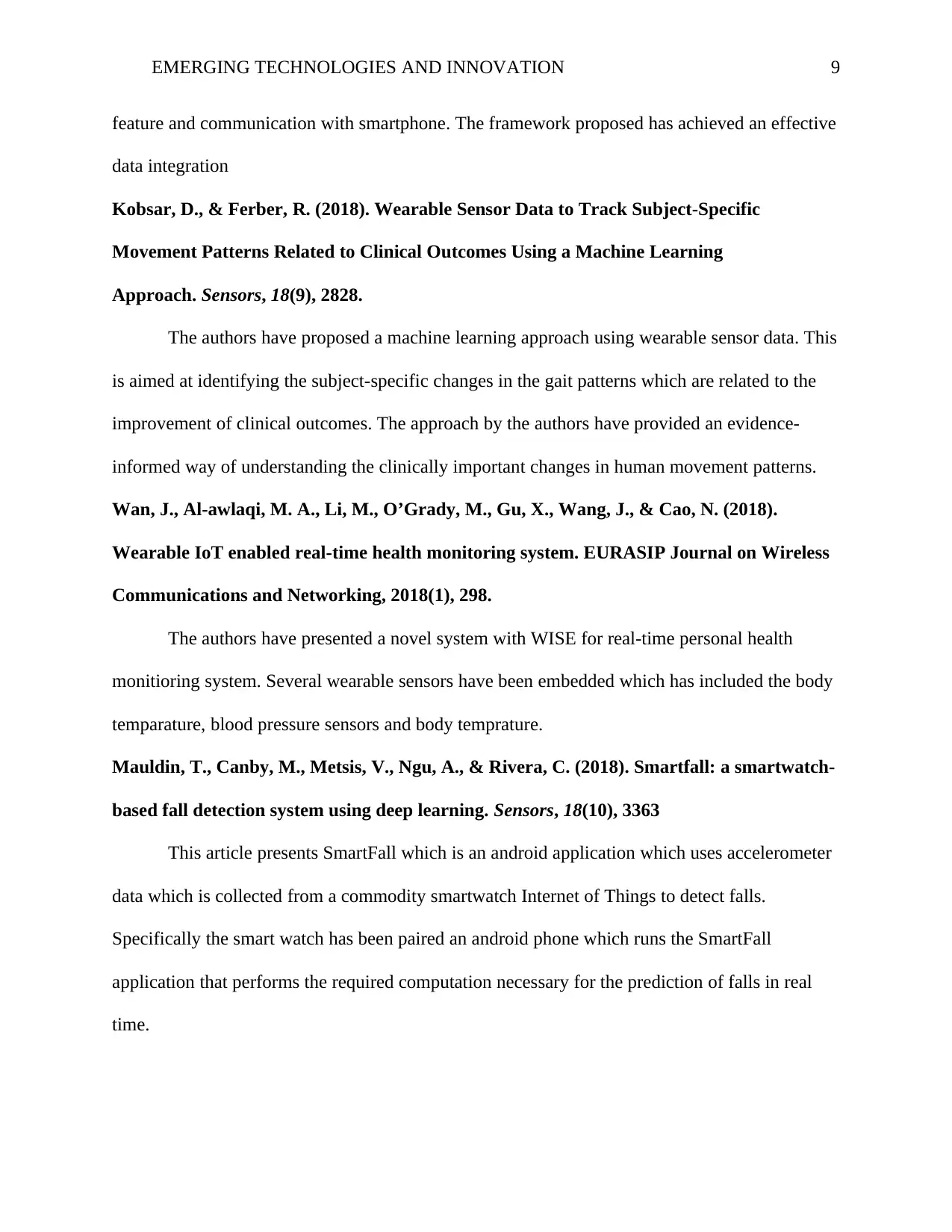
EMERGING TECHNOLOGIES AND INNOVATION 9
feature and communication with smartphone. The framework proposed has achieved an effective
data integration
Kobsar, D., & Ferber, R. (2018). Wearable Sensor Data to Track Subject-Specific
Movement Patterns Related to Clinical Outcomes Using a Machine Learning
Approach. Sensors, 18(9), 2828.
The authors have proposed a machine learning approach using wearable sensor data. This
is aimed at identifying the subject-specific changes in the gait patterns which are related to the
improvement of clinical outcomes. The approach by the authors have provided an evidence-
informed way of understanding the clinically important changes in human movement patterns.
Wan, J., Al-awlaqi, M. A., Li, M., O’Grady, M., Gu, X., Wang, J., & Cao, N. (2018).
Wearable IoT enabled real-time health monitoring system. EURASIP Journal on Wireless
Communications and Networking, 2018(1), 298.
The authors have presented a novel system with WISE for real-time personal health
monitioring system. Several wearable sensors have been embedded which has included the body
temparature, blood pressure sensors and body temprature.
Mauldin, T., Canby, M., Metsis, V., Ngu, A., & Rivera, C. (2018). Smartfall: a smartwatch-
based fall detection system using deep learning. Sensors, 18(10), 3363
This article presents SmartFall which is an android application which uses accelerometer
data which is collected from a commodity smartwatch Internet of Things to detect falls.
Specifically the smart watch has been paired an android phone which runs the SmartFall
application that performs the required computation necessary for the prediction of falls in real
time.
feature and communication with smartphone. The framework proposed has achieved an effective
data integration
Kobsar, D., & Ferber, R. (2018). Wearable Sensor Data to Track Subject-Specific
Movement Patterns Related to Clinical Outcomes Using a Machine Learning
Approach. Sensors, 18(9), 2828.
The authors have proposed a machine learning approach using wearable sensor data. This
is aimed at identifying the subject-specific changes in the gait patterns which are related to the
improvement of clinical outcomes. The approach by the authors have provided an evidence-
informed way of understanding the clinically important changes in human movement patterns.
Wan, J., Al-awlaqi, M. A., Li, M., O’Grady, M., Gu, X., Wang, J., & Cao, N. (2018).
Wearable IoT enabled real-time health monitoring system. EURASIP Journal on Wireless
Communications and Networking, 2018(1), 298.
The authors have presented a novel system with WISE for real-time personal health
monitioring system. Several wearable sensors have been embedded which has included the body
temparature, blood pressure sensors and body temprature.
Mauldin, T., Canby, M., Metsis, V., Ngu, A., & Rivera, C. (2018). Smartfall: a smartwatch-
based fall detection system using deep learning. Sensors, 18(10), 3363
This article presents SmartFall which is an android application which uses accelerometer
data which is collected from a commodity smartwatch Internet of Things to detect falls.
Specifically the smart watch has been paired an android phone which runs the SmartFall
application that performs the required computation necessary for the prediction of falls in real
time.
⊘ This is a preview!⊘
Do you want full access?
Subscribe today to unlock all pages.

Trusted by 1+ million students worldwide
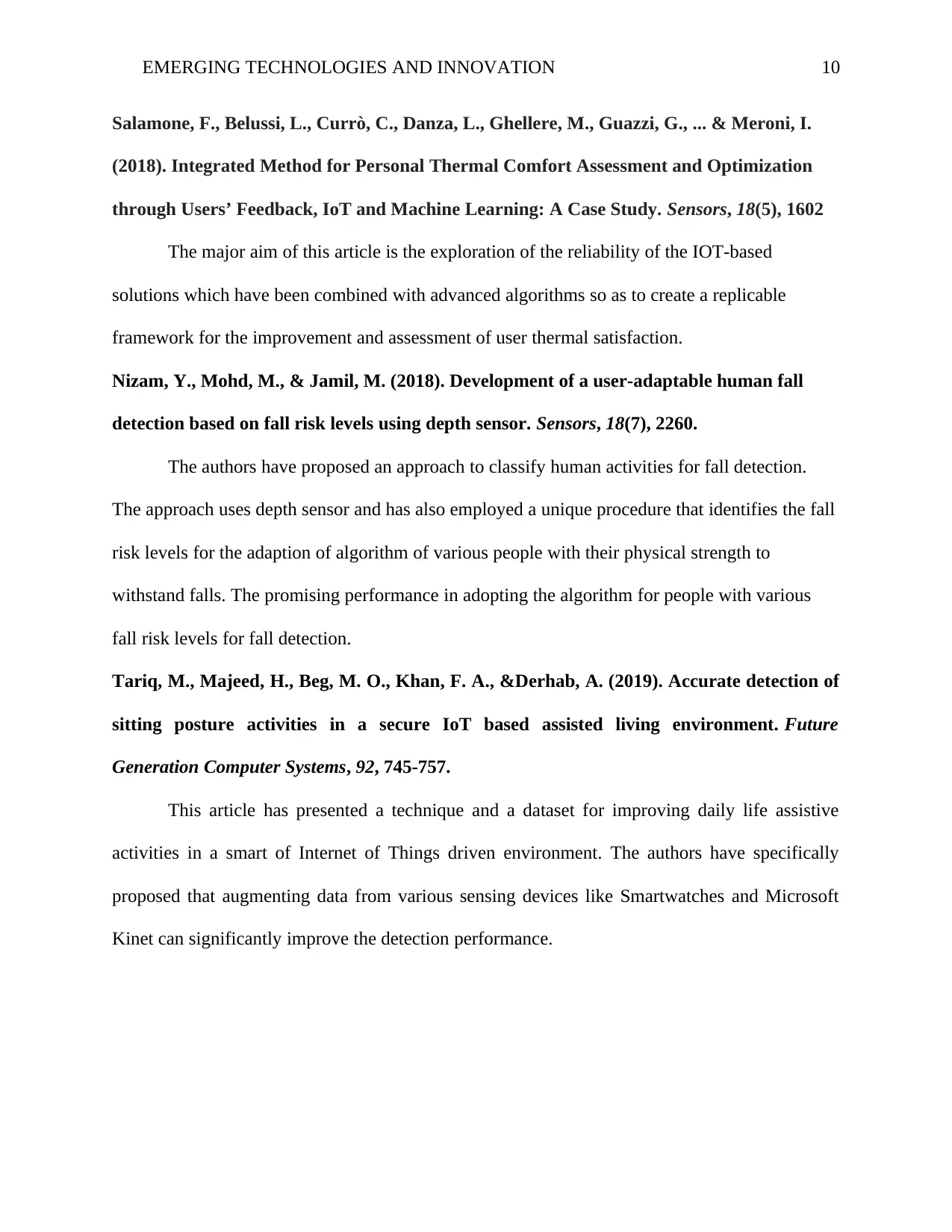
EMERGING TECHNOLOGIES AND INNOVATION 10
Salamone, F., Belussi, L., Currò, C., Danza, L., Ghellere, M., Guazzi, G., ... & Meroni, I.
(2018). Integrated Method for Personal Thermal Comfort Assessment and Optimization
through Users’ Feedback, IoT and Machine Learning: A Case Study. Sensors, 18(5), 1602
The major aim of this article is the exploration of the reliability of the IOT-based
solutions which have been combined with advanced algorithms so as to create a replicable
framework for the improvement and assessment of user thermal satisfaction.
Nizam, Y., Mohd, M., & Jamil, M. (2018). Development of a user-adaptable human fall
detection based on fall risk levels using depth sensor. Sensors, 18(7), 2260.
The authors have proposed an approach to classify human activities for fall detection.
The approach uses depth sensor and has also employed a unique procedure that identifies the fall
risk levels for the adaption of algorithm of various people with their physical strength to
withstand falls. The promising performance in adopting the algorithm for people with various
fall risk levels for fall detection.
Tariq, M., Majeed, H., Beg, M. O., Khan, F. A., &Derhab, A. (2019). Accurate detection of
sitting posture activities in a secure IoT based assisted living environment. Future
Generation Computer Systems, 92, 745-757.
This article has presented a technique and a dataset for improving daily life assistive
activities in a smart of Internet of Things driven environment. The authors have specifically
proposed that augmenting data from various sensing devices like Smartwatches and Microsoft
Kinet can significantly improve the detection performance.
Salamone, F., Belussi, L., Currò, C., Danza, L., Ghellere, M., Guazzi, G., ... & Meroni, I.
(2018). Integrated Method for Personal Thermal Comfort Assessment and Optimization
through Users’ Feedback, IoT and Machine Learning: A Case Study. Sensors, 18(5), 1602
The major aim of this article is the exploration of the reliability of the IOT-based
solutions which have been combined with advanced algorithms so as to create a replicable
framework for the improvement and assessment of user thermal satisfaction.
Nizam, Y., Mohd, M., & Jamil, M. (2018). Development of a user-adaptable human fall
detection based on fall risk levels using depth sensor. Sensors, 18(7), 2260.
The authors have proposed an approach to classify human activities for fall detection.
The approach uses depth sensor and has also employed a unique procedure that identifies the fall
risk levels for the adaption of algorithm of various people with their physical strength to
withstand falls. The promising performance in adopting the algorithm for people with various
fall risk levels for fall detection.
Tariq, M., Majeed, H., Beg, M. O., Khan, F. A., &Derhab, A. (2019). Accurate detection of
sitting posture activities in a secure IoT based assisted living environment. Future
Generation Computer Systems, 92, 745-757.
This article has presented a technique and a dataset for improving daily life assistive
activities in a smart of Internet of Things driven environment. The authors have specifically
proposed that augmenting data from various sensing devices like Smartwatches and Microsoft
Kinet can significantly improve the detection performance.
Paraphrase This Document
Need a fresh take? Get an instant paraphrase of this document with our AI Paraphraser
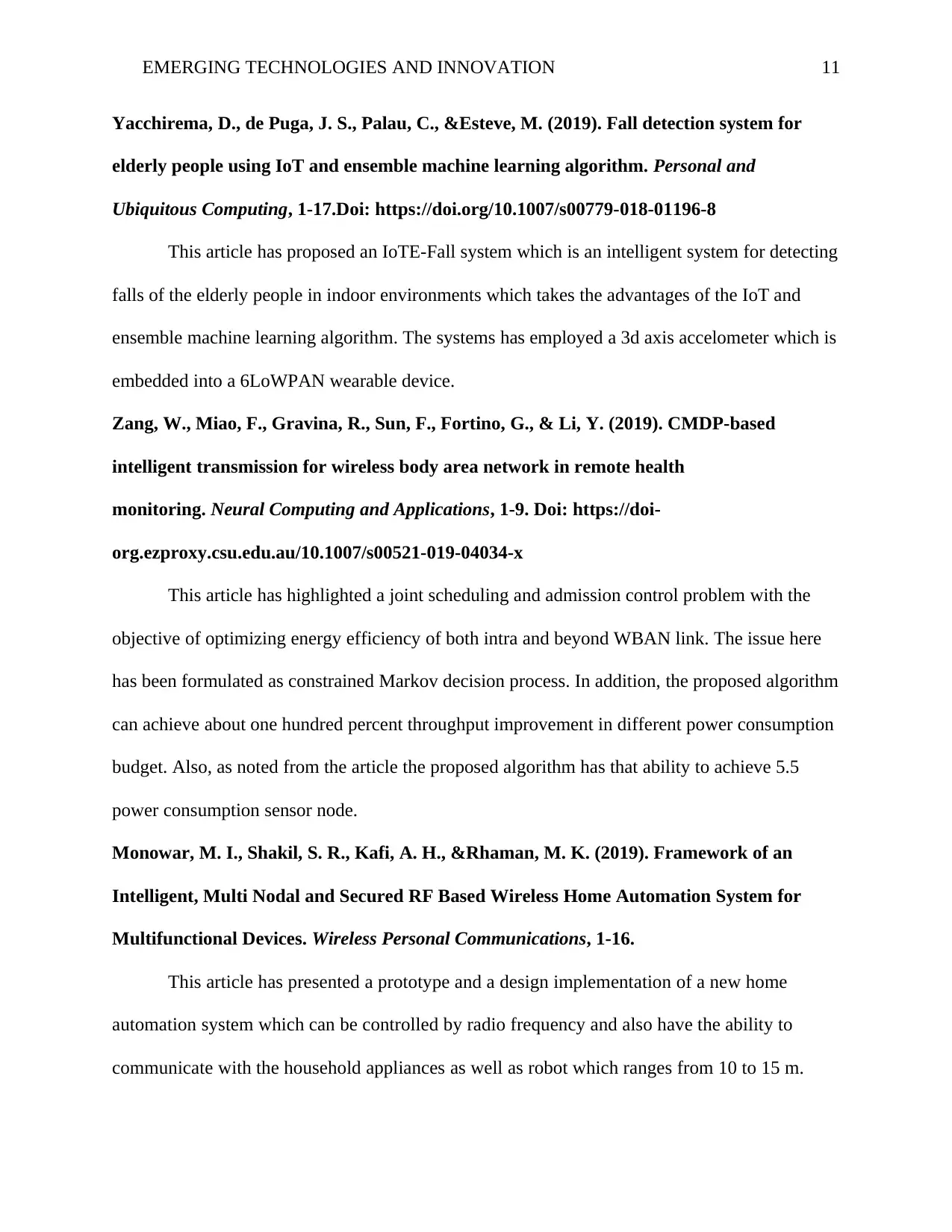
EMERGING TECHNOLOGIES AND INNOVATION 11
Yacchirema, D., de Puga, J. S., Palau, C., &Esteve, M. (2019). Fall detection system for
elderly people using IoT and ensemble machine learning algorithm. Personal and
Ubiquitous Computing, 1-17.Doi: https://doi.org/10.1007/s00779-018-01196-8
This article has proposed an IoTE-Fall system which is an intelligent system for detecting
falls of the elderly people in indoor environments which takes the advantages of the IoT and
ensemble machine learning algorithm. The systems has employed a 3d axis accelometer which is
embedded into a 6LoWPAN wearable device.
Zang, W., Miao, F., Gravina, R., Sun, F., Fortino, G., & Li, Y. (2019). CMDP-based
intelligent transmission for wireless body area network in remote health
monitoring. Neural Computing and Applications, 1-9. Doi: https://doi-
org.ezproxy.csu.edu.au/10.1007/s00521-019-04034-x
This article has highlighted a joint scheduling and admission control problem with the
objective of optimizing energy efficiency of both intra and beyond WBAN link. The issue here
has been formulated as constrained Markov decision process. In addition, the proposed algorithm
can achieve about one hundred percent throughput improvement in different power consumption
budget. Also, as noted from the article the proposed algorithm has that ability to achieve 5.5
power consumption sensor node.
Monowar, M. I., Shakil, S. R., Kafi, A. H., &Rhaman, M. K. (2019). Framework of an
Intelligent, Multi Nodal and Secured RF Based Wireless Home Automation System for
Multifunctional Devices. Wireless Personal Communications, 1-16.
This article has presented a prototype and a design implementation of a new home
automation system which can be controlled by radio frequency and also have the ability to
communicate with the household appliances as well as robot which ranges from 10 to 15 m.
Yacchirema, D., de Puga, J. S., Palau, C., &Esteve, M. (2019). Fall detection system for
elderly people using IoT and ensemble machine learning algorithm. Personal and
Ubiquitous Computing, 1-17.Doi: https://doi.org/10.1007/s00779-018-01196-8
This article has proposed an IoTE-Fall system which is an intelligent system for detecting
falls of the elderly people in indoor environments which takes the advantages of the IoT and
ensemble machine learning algorithm. The systems has employed a 3d axis accelometer which is
embedded into a 6LoWPAN wearable device.
Zang, W., Miao, F., Gravina, R., Sun, F., Fortino, G., & Li, Y. (2019). CMDP-based
intelligent transmission for wireless body area network in remote health
monitoring. Neural Computing and Applications, 1-9. Doi: https://doi-
org.ezproxy.csu.edu.au/10.1007/s00521-019-04034-x
This article has highlighted a joint scheduling and admission control problem with the
objective of optimizing energy efficiency of both intra and beyond WBAN link. The issue here
has been formulated as constrained Markov decision process. In addition, the proposed algorithm
can achieve about one hundred percent throughput improvement in different power consumption
budget. Also, as noted from the article the proposed algorithm has that ability to achieve 5.5
power consumption sensor node.
Monowar, M. I., Shakil, S. R., Kafi, A. H., &Rhaman, M. K. (2019). Framework of an
Intelligent, Multi Nodal and Secured RF Based Wireless Home Automation System for
Multifunctional Devices. Wireless Personal Communications, 1-16.
This article has presented a prototype and a design implementation of a new home
automation system which can be controlled by radio frequency and also have the ability to
communicate with the household appliances as well as robot which ranges from 10 to 15 m.
1 out of 11
Related Documents
Your All-in-One AI-Powered Toolkit for Academic Success.
+13062052269
info@desklib.com
Available 24*7 on WhatsApp / Email
![[object Object]](/_next/static/media/star-bottom.7253800d.svg)
Unlock your academic potential
Copyright © 2020–2025 A2Z Services. All Rights Reserved. Developed and managed by ZUCOL.


